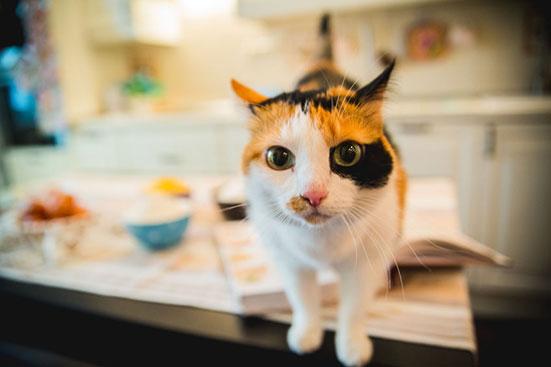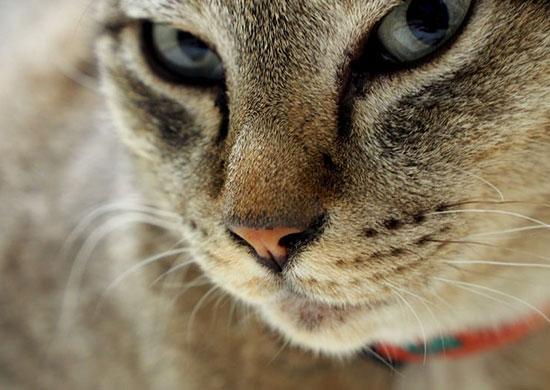This content is archived from the Feline Nutrition Foundation
How to Think Like a Cat
- Updated: Saturday, May 18, 2019 02:43 PM
- Published: Saturday, October 20, 2018 12:10 PM
- Written by Margaret Gates
Like anyone involved professionally with cats, I spend a lot of time trying to figure them out. That means really trying to understand how they think. As much as we count them as part of the family, they are not little humans. While some of their behaviors seem similar to ours, understanding what motivates them can be difficult. There is always the danger of attributing to them more than is really there.
Recently, a friend told me a story about her son and his wife. They are new cat owners and love their cat dearly. They travel a lot. Her son reports their cat has taken to going off and peeing on shoes when she sees the suitcases come out. He said they tried punishing her (oh, no!), but that hadn't worked. They felt their kitty was mad at them and trying to get back at them for leaving.
This is an example of putting way too much human behavior onto your cat. It's not that complicated. Yes, she is smart enough to understand that the suitcases mean they are going to leave. Cats are very good at remembering the consequences of certain actions, if it affects them. But she isn't mad at them, she's just upset. The peeing isn't vindictive – that is beyond the thinking of a cat – she is simply doing something to make herself feel better. It's not about you. Relieving herself on an object makes it smell like her. It's comforting. She is upset and does something that makes her feel better. It's that simple. Get it out of your head that your cat is plotting against you. They have no concept of doing things out of spite.
This is why punishment would never have worked. It is only in our minds that the cat did anything wrong. To her, punishment would simply be her humans being mean for no reason at all. That's a great way to make your cat afraid of you. I was relieved to hear the couple solved the problem by simply putting her in another room when it was time to pack. She never has to see the suitcases at all.
This example does show how good cats are at basic cause and effect: suitcases = humans leaving. Just don't let yourself extrapolate that into thinking they know about effects that aren't visible or are off into the future. They don't understand that their actions might affect your future feelings. Their ability to plan doesn't go that far. Yes, that means cats aren't planning world domination. They aren't capable of it.
 That cats understand some types of cause and effect is often pretty impressive. They don't need much repetition either. A while back, I had to take my cat Bunny to the vet. It had been a long while since she had gone there. I got out the carrier downstairs in the kitchen, and then went upstairs to get her. I picked her up, carried her down the stairs and put her in the carrier. No problem. About three weeks later, she had to go again for a follow-up. I did the same thing, but this time, the moment I started down the stairs with her in my arms, she stiffened and got agitated. She had remembered from just one experience that being carried down the stairs meant something bad was going to happen. When I thought about it, I realized that I frequently carried her from room to room and sometimes up the stairs, but never down the stairs until that vet trip. That's one smart kitty.You can take advantage of a cat's ability to understand basic cause and effect to train them, as long as the action and the effect are real-world, immediate and obvious. When I was a kid, we trained all of our cats to come when called. This was an era when we let them outside, so this was important. We started when they were kittens. We would open a can of food, give them a taste, then walk six feet away and tap the can with the fork. When they came to us, they got a bite of food. We kept increasing the distance, but it only ever took one or two repetitions to train them that fork tap = food. For the rest of their lives, they would come running whenever we tapped a fork on a can. A can of peas worked just as well as cat food, too.Some people say that cats are solitary creatures and can do without us. Not so. They are actually quite social, even amongst themselves. There was a study of semi-feral barn cats. The females were social with each other, shared nursing responsibilities for the many litters of kittens and spent lots of time with each other, grooming and parenting. As long as food was plentiful. Once food was scarce, they ceased being social as they had to take care of themselves first.¹
That cats understand some types of cause and effect is often pretty impressive. They don't need much repetition either. A while back, I had to take my cat Bunny to the vet. It had been a long while since she had gone there. I got out the carrier downstairs in the kitchen, and then went upstairs to get her. I picked her up, carried her down the stairs and put her in the carrier. No problem. About three weeks later, she had to go again for a follow-up. I did the same thing, but this time, the moment I started down the stairs with her in my arms, she stiffened and got agitated. She had remembered from just one experience that being carried down the stairs meant something bad was going to happen. When I thought about it, I realized that I frequently carried her from room to room and sometimes up the stairs, but never down the stairs until that vet trip. That's one smart kitty.You can take advantage of a cat's ability to understand basic cause and effect to train them, as long as the action and the effect are real-world, immediate and obvious. When I was a kid, we trained all of our cats to come when called. This was an era when we let them outside, so this was important. We started when they were kittens. We would open a can of food, give them a taste, then walk six feet away and tap the can with the fork. When they came to us, they got a bite of food. We kept increasing the distance, but it only ever took one or two repetitions to train them that fork tap = food. For the rest of their lives, they would come running whenever we tapped a fork on a can. A can of peas worked just as well as cat food, too.Some people say that cats are solitary creatures and can do without us. Not so. They are actually quite social, even amongst themselves. There was a study of semi-feral barn cats. The females were social with each other, shared nursing responsibilities for the many litters of kittens and spent lots of time with each other, grooming and parenting. As long as food was plentiful. Once food was scarce, they ceased being social as they had to take care of themselves first.¹





